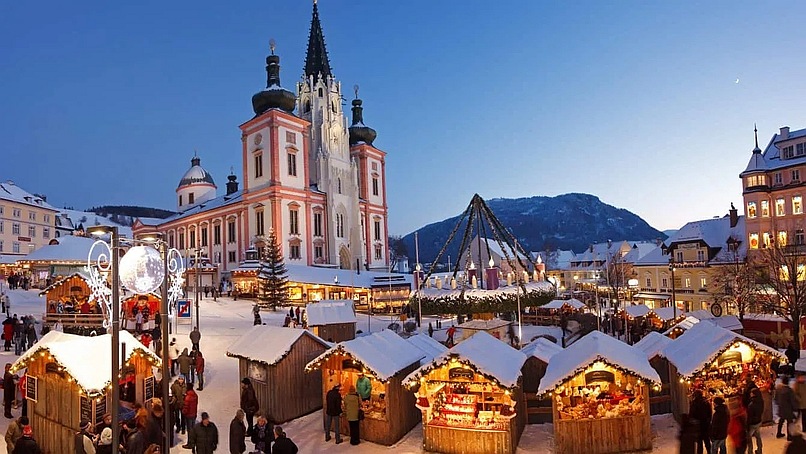

The charming mountainous region surrounding Maria Zell (contracted to Mariazell in modern Austria) was prior to the eighth century only a wilderness. Only a few shepherds migrated here to graze their flocks. The region belonged to the domains of the powerful Counts of Avelanz, Eppenstein and Müztal – later the Dukes of Kärnten (Carinthia) – until their lineage died out in 1127.
A regent from this famous House, Duke Marquart, founded in the year 1073 the Benedictine Abbey of St. Lambrecht in Styria (image below), on the border of Carinthia, and granted to it the district of Avelanz – which, in addition to the valleys of Aflenz and Veitch, also included the entire district which comprises present-day Mariazell. It is true that this pious prince did not live to see the expansion of the monastery and the church; but his son Heinrich undertook the completion of these buildings, and in the years 1096 and 1104 issued the letters of foundation, which were also confirmed by Emperor Heinrich IV. So this inhospitable border region came under the rule of a Religious Order, which certainly cannot be denied the great merit of having transformed this great wilderness into charming meadows in the most desolate part of Austria, from which the rich blessings of many a happy farmer smile upon us.
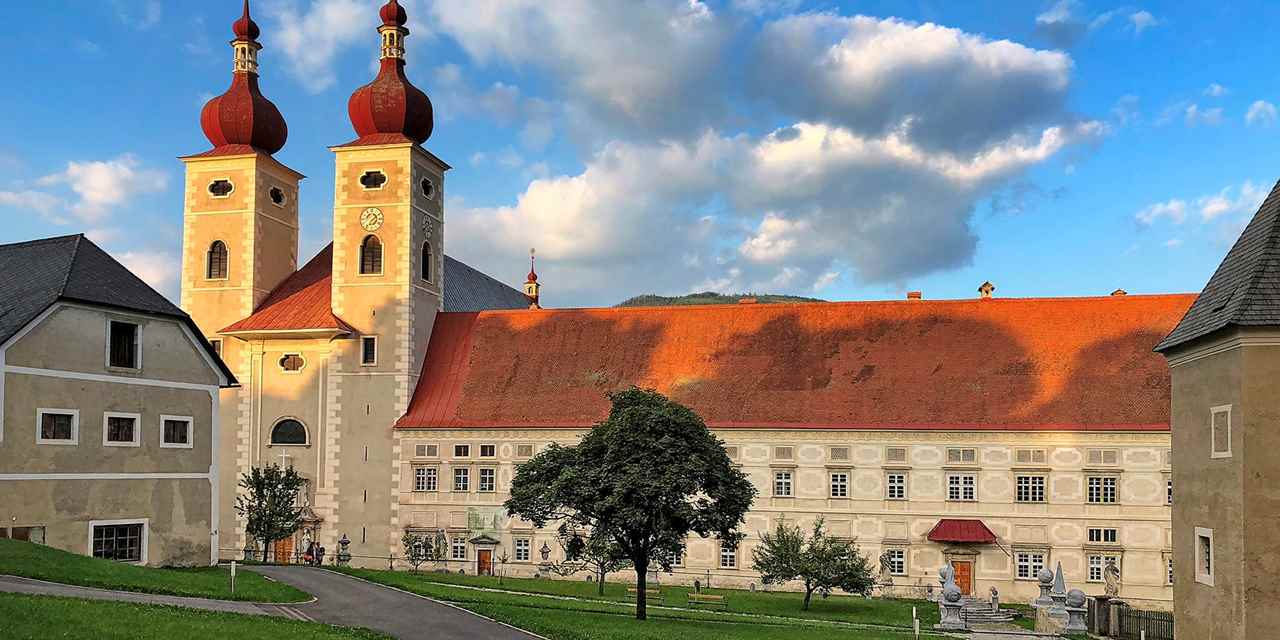
Otto VII, Abbot of the Monastery of St. Lambrecht, concerned for the salvation of his subjects and the development of the neglected Avelanz region, sought and received permission from Pope Hadrian VI to employ five priests of his monastery as pastors in the valley of Aflenz. But since in the almost inaccessible northern part of that wilderness, where Mariazell is at present, there were also some shepherds who could not possibly be provided with spiritual help from Aflenz, one of the five priests mentioned was sent to that region to set up his permanent residence there.
This priest, whose name has not come down to us in any document, but who tradition calls Magnus, arrived on December 21, 1157 at the place of his destiny. Whether he arrived on foot or on horseback, what he brought with him, whether he first built his wooden cell or found it already built, we can not discover; we only know from credible tradition and documents that he moved into a wooden cell on the so-called Sand Hill on the southwestern lowlands of a mountain, which today is called the Bürgeralpe. Local legend has it that at some point in his journey, he could not proceed because of the density of the forest; he also saw that, further on, a large rock was blocking his passage. After praying to Our Lady he saw the forest open and the rock split in two in order to make way for him. Upon a linden tree trunk near this cell, he placed his beloved linden wood statue of Mary, which he had brought with him – the same one that can still be seen today on the Altar of Grace (Gnadenaltar), and which is perfectly well preserved except for a little fading of the colors.
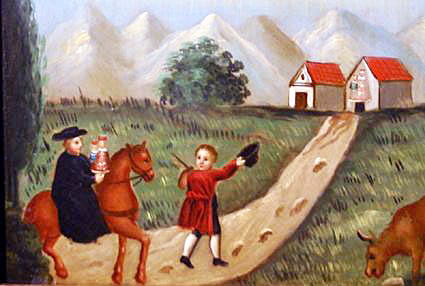 The choice of this place was certainly very expedient, situated as it is between several large valleys, such as the Erlauftal,
the Grünautal, the Halltal, the Salzatal, and the Aschbachtal. Two old paintings – one over the main entrance of the Church,
the other opposite the Treasury, at the entrance to the gallery – represent the arrival of this priest. The wooden cell can
also be seen on the latter, which had two divisions and served both as a dwelling and as a chapel. At that time there were
probably already several other dwellings in this convenient location. Here the pious priest led a hermit's life in the true
sense of the word, completely devoted to his difficult profession.
The choice of this place was certainly very expedient, situated as it is between several large valleys, such as the Erlauftal,
the Grünautal, the Halltal, the Salzatal, and the Aschbachtal. Two old paintings – one over the main entrance of the Church,
the other opposite the Treasury, at the entrance to the gallery – represent the arrival of this priest. The wooden cell can
also be seen on the latter, which had two divisions and served both as a dwelling and as a chapel. At that time there were
probably already several other dwellings in this convenient location. Here the pious priest led a hermit's life in the true
sense of the word, completely devoted to his difficult profession.
His genuine piety, and his excellent zeal for spreading the Christian virtues among the simple mountain dwellers, soon attracted believers from afar, who heard the word of God from his mouth, and in that poor wooden cell, in front of that simple statue, implored in childlike trust the intercession of the loving Mother of the Savior. Many found solace and help, and the influx of people became larger and more frequent. We do not know how long this priest lived and taught here and who succeeded him. But the faithful continue making pilgrimages, with ever-increasing confidence, to the image of the Virgin Mary in the wooden cell, and the inhospitable nature of the region only seemed to increase their enthusiasm. Eventually the place became known as the Mary Cell (Maria Zell).
The reputation of the miraculous image spread even to distant lands and, scarcely fifty years after the arrival of the first priest in this region, brought about an event which was the main cause of the rise of this place as a pilgrimage destination. Henry I, or as the Bohemians call him, Wratislav, Margrave of Moravia, and his wife lay ill for several years. They had a vision in a dream, which encouraged them to put their trust in the intercession of the Blessed Virgin and, after their recovery, to go to Mariazell personally to show their gratitude. They did as they were instructed and recovered; whereupon they gratefully hurried to the designated place, gave the most fervent thanks, and at the end of the 12th or beginning of the 13th century, built a stone chapel for the Image of Grace or Gnadenbild (also referred to as the Statue of Grace or Gnadenstatue), which still stands today in the middle of the main church.
This event greatly increased the reputation of the miraculous Gnadenbild in Mariazell. It was probably at that time
that many houses were built on the hill to accommodate the numerous pilgrims, and that the surrounding area was cleared for
cultivation by the permanent residents. The 14th Abbot of St. Lambrecht, Hermann, in 1243, based on his request to Duke Frederick II,
was granted the full power of free administration, even in that forest which lies within the Aflenz valley, and is called Zell.
 Almost a century later, in 1330, at the request of Adolf the 24th Abbot, a forty-day indulgence was granted to the
pilgrimages to Mariazell by Frederick III, Prince-Archbishop of Salzburg, to whose diocese Mariazell belonged. At the same time,
the same Abbot received permission from this Archbishop to build a church for the numerous pilgrims at the foot of the Seeberg.
Documents of the secular courts from this time period conceded that a pilgrimage to Mariazell could be imposed as a legal penalty
upon those found guilty of certain crimes.
Almost a century later, in 1330, at the request of Adolf the 24th Abbot, a forty-day indulgence was granted to the
pilgrimages to Mariazell by Frederick III, Prince-Archbishop of Salzburg, to whose diocese Mariazell belonged. At the same time,
the same Abbot received permission from this Archbishop to build a church for the numerous pilgrims at the foot of the Seeberg.
Documents of the secular courts from this time period conceded that a pilgrimage to Mariazell could be imposed as a legal penalty
upon those found guilty of certain crimes.
The splendor of this place of pilgrimage rose even higher throughout the 14th century, when Ludwig I, King of Hungary
(image left) – in gratitude for a significant victory he won over a superior enemy, which outnumbered his force fourfold –
surrounded the small chapel with a full-sized church with a beautiful Gothic tower. The tower is still to be seen to this day adorning
the present church. This king, a descendant of the famous house of Anjou, and called by his contemporaries Ludwig the Great, ascended
the Hungarian throne after his father in 1342; and later, as the nephew of King Casimir of Poland, he also ascended the throne of Poland,
and waged many wars against the Poles, Lithuanians, Venetians, Bulgarians and Bosnians. He seems to have won the above-mentioned victory
over the Bosnians, since tradition calls them Turks, and at that time all peoples who came from the barbaric lands to the north of
present-day Turkey and who were considered wild and cruel, whether Islamic or not, were referred to by the name of Turks.
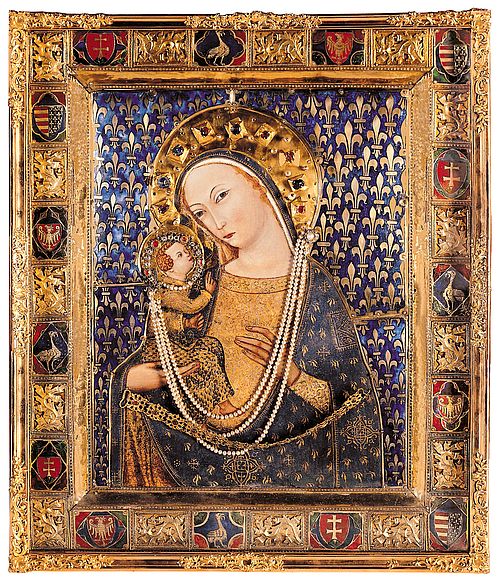 This prince was a zealous devotee of Mary, the Mother of God and trusted greatly in Her intercession, which is why he also decorated
his domestic chapel with an image of the Virgin Mary (image right), and took it with him every time he went to war. Before
the above-mentioned battle, when greatly outnumbered, he prayed before this image until he fell asleep. A vision in a dream
encouraged him to battle, and when he awoke he found the picture lying on his breast. Taking this as a sure sign of success,
the confident king bravely attacked the enemy, and in fact won a brilliant victory. Driven by deepest feelings of gratitude,
he made a pilgrimage to Mariazell and built the church mentioned above. In addition to his and his wife's wedding dresses and coats,
his stirrups, spurs and victorious sword, Ludwig also offered Our Lady the image of Her from his domestic chapel as a gift,
which was later richly embellished by Maximilian, Archduke of Austria, and by many high-ranking persons. It still adorns the
Treasury today, where it is known as the Treasury Marian Image (Schatzkammer Marienbild).
This prince was a zealous devotee of Mary, the Mother of God and trusted greatly in Her intercession, which is why he also decorated
his domestic chapel with an image of the Virgin Mary (image right), and took it with him every time he went to war. Before
the above-mentioned battle, when greatly outnumbered, he prayed before this image until he fell asleep. A vision in a dream
encouraged him to battle, and when he awoke he found the picture lying on his breast. Taking this as a sure sign of success,
the confident king bravely attacked the enemy, and in fact won a brilliant victory. Driven by deepest feelings of gratitude,
he made a pilgrimage to Mariazell and built the church mentioned above. In addition to his and his wife's wedding dresses and coats,
his stirrups, spurs and victorious sword, Ludwig also offered Our Lady the image of Her from his domestic chapel as a gift,
which was later richly embellished by Maximilian, Archduke of Austria, and by many high-ranking persons. It still adorns the
Treasury today, where it is known as the Treasury Marian Image (Schatzkammer Marienbild).
The number of pilgrims was increased all the more by these events and so a larger number of inns was required to
accommodate the strangers. Gradually, a small village came into being and was elevated to market-town status by Albrecht,
Duke of Austria, Styria and Carinthia, by a document dated St. Matthew's Day, 1342. Thereupon Pope Clement VI issued from Avignon
the first papal bull of indulgences for Mariazell in 1346, in which His Holiness granted annually: to all those who have truly
repented and confessed, and, on the four main Feasts of the Blessed Virgin, as well as on Ascension Day and on the Anniversary of
its Dedication, have visited this church (of Mariazell) devoutly
an indulgence of one hundred days.
From that time on, our place of pilgrimage received various kinds of favors from several noble rulers from the House of Hapsburg. In 1364, Rudolf I founded a perpetual Mass for himself and his descendants, for which purpose he gave the church at Mariazell a hundred Viennese pounds. Ernst I enriched the Treasury Image, and in 1414 requested that in both the liturgy and sermons, his intentions and those of his brother Frederick and his wife Cimburga, should be remembered publicly.
In the first half of the 15th century, the horrors of the Faustrecht (which we would now call the law of the
jungle
or might makes right
) reached a terrible height throughout Germany and Austria. Many knights believed they
had the right to vanquish and despoil those who were weaker. They became known as robber barons
(Raubrittern),
sometimes exacting unjust tolls from travelers, sometimes robbing them outright. They would build their strongholds in hidden places
from which they could watch the paths and streets unnoticed. Highway robbery
was almost exclusively carried out by these
robber barons, and the strictest measures of energetic monarchs could not put a stop to this mischief for a long time. No one was
safe on the open road as to his belongings and even his life, and it was customary to travel only under strong escort. It is easy
to imagine what happened to the poor pilgrims who made the pilgrimage to Mariazell.
Heinrich II, Abbot of St. Lambrecht, felt compelled to ask Emperor Sigismund for a letter of safe conduct for these pilgrims, and it was granted on the Monday before the Feast of St. Laurence, 1429. Cardinal Giuliano Cesarini, who in the name of Pope Eugene IV convoked the Council of Basel, ratified this document in 1442 with the approval of the Holy Council and obtained the Church's confirmation, which threatened to excommunicate all Christians who would place any obstacle in the way of pilgrims to Mariazell.
The same Abbot Heinrich who obtained these documents, with the permission of the Patriarch of Aquileia Alexander, built the chapel in honor of Saint Sigmund on the so-called Kreuzberg (now called Sigmundsberg) in 1443. Since later the danger of enemy raids made it necessary to build a few strongholds to protect the church and the Treasury of Mariazell, Emperor Friedrich approved the construction of a castle on this Kreuzberg in 1464 and another on a rugged rock near Thörl, which received the name Burg Schachenstein. Of these, magnificent, forest-covered ruins remain – the former was completely destroyed by the soldiers of Matthias Corvinus in 1485.
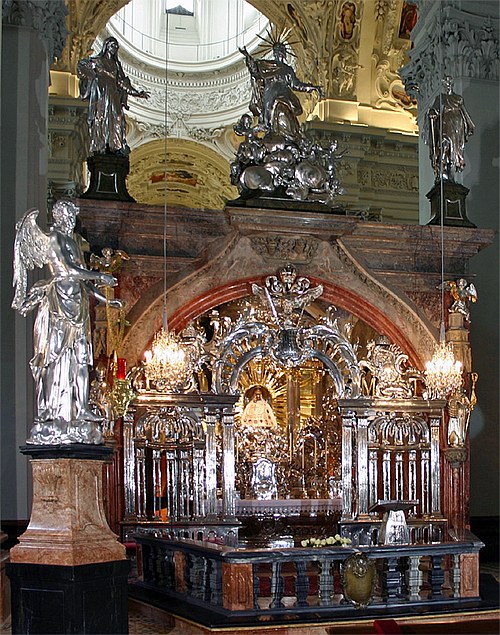 In the 16th century, Mariazell twice suffered significant fire damage. When the Turks plundered Styria in 1529,
they reduced the town to ashes and, according to legend, shot flaming arrows at the church, which, nevertheless remained unharmed.
In 1566, on St. Bartholomew's Day, a fire suddenly broke out and destroyed 37 houses. The town, however, soon recovered from these
misfortunes, as the increasing security of the roads and highways allowed a numerous influx of generous pilgrims. These increased
so much in the 17th century that an extension of the church had to be made, which until then was quite narrow and did not permit
passage behind the Gnadenkapelle.
In the 16th century, Mariazell twice suffered significant fire damage. When the Turks plundered Styria in 1529,
they reduced the town to ashes and, according to legend, shot flaming arrows at the church, which, nevertheless remained unharmed.
In 1566, on St. Bartholomew's Day, a fire suddenly broke out and destroyed 37 houses. The town, however, soon recovered from these
misfortunes, as the increasing security of the roads and highways allowed a numerous influx of generous pilgrims. These increased
so much in the 17th century that an extension of the church had to be made, which until then was quite narrow and did not permit
passage behind the Gnadenkapelle.
Abbot Benedikt Pirin, encouraged and supported by Emperor Ferdinand III, laid the foundation stone for a new church building on May 6, 1644, giving the old church, built by King Ludwig 281 years earlier, a completely different style – Baroque, except for the beautiful Gothic central tower. The church was made much wider, and twice as long as before. It also received two beautiful side towers (giving it the unique feature of having three towers), and over the Statue of Mary in Her Gnadenkapelle (image left), was vaulted a magnificent dome – in short, the church received essentially the same form that it has today.
A delay in construction was partly due to the plague that broke out in Mariazell in 1679, and partly to the dreadful gloom caused by fear of the Turks, who had advanced as far as Vienna. On the first occasion the Statue of Grace was carried around the town in a solemn votive procession; but when Kara Mustapha himself besieged Vienna in 1683, Abbot Franz had both this Statue and the Treasury Image together with all the other treasures transferred to St. Lambrecht, for the sake of caution. Both Images remained exposed for veneration there until they could be safely transferred back to Mariazell, after the Turks were vanquished at Vienna by Sobieski. Upon its completion in 1683, the church was dedicated to the Nativity of Mary. In 1704 the magnificent high altar was consecrated. It is said that during this reconstruction work, the linden tree that had been the original dwelling place of the Gnadenstatue, was found.
Throughout the 17th century and the next, most of the regents from the Austrian nobility frequently performed their devotions at this place of pilgrimage and offered significant gifts. At the beginning of the 18th century, the influx of pilgrims to Mariazell, already so significant, was such that according to a document issued in 1718 by the Prince Bishop of Seckau and Vicar General of the Archdiocese of Salzburg, Count Dominik von Lamberg, the number of pilgrims reached 120,000 every year thereafter, and Mariazell was as famous in the Austrian states as Loreto was in Italy. Thus it was named the national shrine of Austria and the Blessed Virgin Mary was named Magna Mater Austriae (the Great Mother of Austria).
Mariazell rose to a significant prosperity and was favored by the St. Lambrecht Abbey, which exercised the sovereign rights over the town and the entire surrounding area, with special protection. Because of the increasing number of pilgrimages from the south, a church was also built in 1710 on that side of the Seeberg, at the initiative of a Countess of Heister. However, the pilgrimages had to be suspended for a while due to a plague that had broken out in Hungary. In 1756 the 600th Anniversary of the arrival of the Gnadenstatue (image below) was celebrated in Mariazell, resulting in the incredible confluence of 373,000 pilgrims.
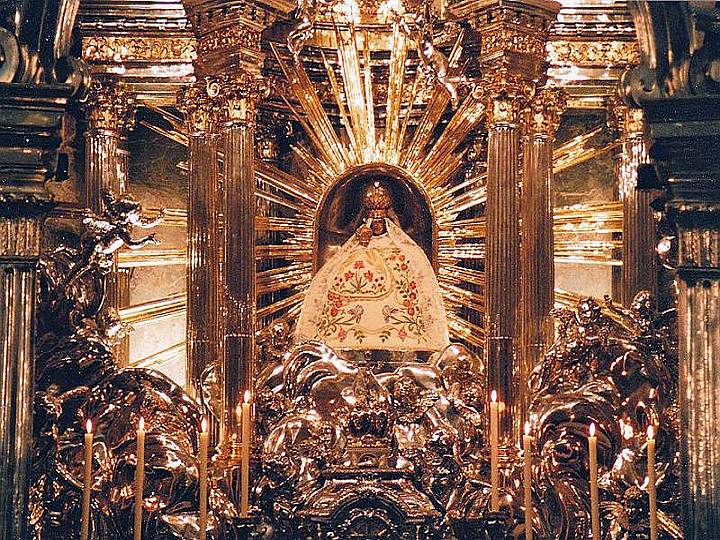
But soon a difficult time came again for this place of pilgrimage. In 1782, Emperor Joseph II, who allowed himself
to be influenced by proponents of the so-called Age of Enlightenment, forbade all solemn ceremonies and pilgrimages in large numbers
throughout the Hapsburg-Lorraine Monarchy, and at the same time ordered that all holy images and statues adorned with ornate clothes
and jewels be stripped of their adornments. Soon after, the Monastery of St. Lambrecht was closed and a large part of the gold and
silver in the treasury was used for the State-controlled religious fund.
During his reign, Joseph suppressed over 700 religious
houses in Austria and Hungary and reduced the number of Religious men and women from 65,000 to 27,000, all the while professing
religious tolerance.
Even the replica of the Holy House of Loreto, built in the Augustinian Church in Vienna by
Eleonor of Gonzaga, was pulled down by order of Emperor Joseph. His policies became known in history as Josephinism – not really
a formal heresy, but a gross imposition of secular power upon the Church. By Joseph's decree, Austrian bishops could not communicate
directly with the Roman Curia anymore. The education of priests was taken from the Church as well. Joseph established six state-run
General Seminaries
– one of the pretenses for robbing the churches and establishing the religious fund.
Unfortunately
there were enough liberal members of the clergy and hierarchy to make it difficult for Rome to react in a forceful manner.
Pope Pius VI, already harassed by Gallicanism, Jansenism, and later, the French Revolution, unwillingly tolerated much of this abuse,
hoping to avoid an open schism. After Napoleon defeated the armies of the Papal States in 1796, he demanded the Pope surrender his
temporal authority. Upon his refusal Pope Pius VI was, in 1798, taken prisoner into France. He died the following year in Valence.
He was not given a proper funeral and burial in Rome until 1802.
It is easy to imagine the state into which the citizens of Mariazell descended, whose livelihood depended solely on pilgrimages, as a result of these decrees. Joseph died in 1790 but the troubles lasted for several more years. Finally, in 1796, Emperor Franz (as the last Holy Roman Emperor he was called Franz II; thereafter as the first Austrian Emperor he was called Franz I) deigned to allow the ceremonial pilgrimage processions into Mariazell again; in the following year the adorning of the Gnadenstatue was again permitted by a separate hand-written decree. The custom was introduced to dress the statue with a new ornate garment every year, more than 150 of which are kept in the Treasury. The pilgrims were then able to come back here unhindered, and everything returned to its former condition.
In the 19th century, Mariazell began to flourish again. In 1802 the monastery of St. Lambrecht was restored and Mariazell could again be provided with numerous priests. The formal return of the Church buildings and rights finally took place in 1804. Pilgrimages increased briskly; for the suffering of the people through the misfortune of war was great, and consolation and help were sought from the gracious Mother of God. Believers from all walks of life flocked in large numbers, and many high-ranking persons came in pious devotion with rich votive gifts. Even the revered Emperor Franz appeared at Mariazell in 1811, and on this occasion lifted all existing restrictions regarding the ceremonial processions of pilgrimage groups, with the stipulation that such crowds be of at least eighty people, and be accompanied by their own or a local priest.
One of the worst fires suffered by the Nativity of Mary Church in Mariazell broke out on the Feast of All Saints in 1827, during which the roof and the three steeples of the church were completely destroyed; even the bells melted. The interior of the church was spared from the fire, but suffered major damage from soot and extinguishing water. The Gnadenstatue was saved by a courageous monk and brought to the chapel on Sigmundsberg. Donations from all over the monarchy helped to repair the damage in the years 1828 to 1830 (image below – depiction of the church in 1838). Various restorations were made throughout the 19th and on into the 20th century.
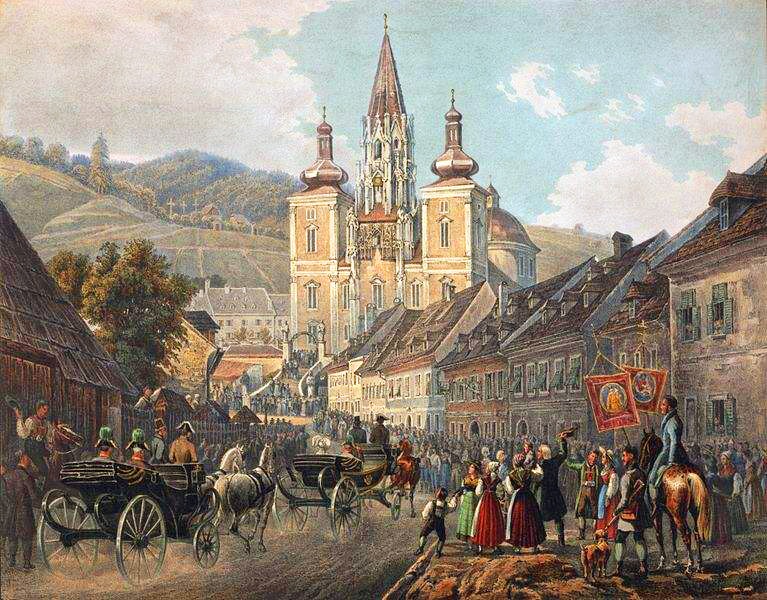
Pope St. Pius X personally raised the Nativity of Mary Church to the status of a minor basilica by a Motu Proprio on November 10, 1907. Later he ordered the coronation of the Gnadenstatue by a Decree on September 8, 1908, Feast of the Nativity of Mary. September 13 is observed as the Feast of Our Lady of Mariazell, and December 21 as the Anniversary of the Foundation of the Shrine – Gründungstag.
It is said no other church or shrine can claim ex-votos of so many different nationalities as Mariazell. The devotion to Our Lady of Mariazell has no national boundaries and Her favors are not accorded within any geographical limits. Situated in the center of a strife-torn region, She is truly honored as the Regina Pacis.
Alphabetical Index; Calendar List of Saints
Contact us: smr@salvemariaregina.info
Visit also: www.marienfried.com